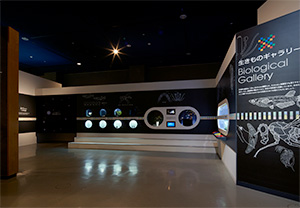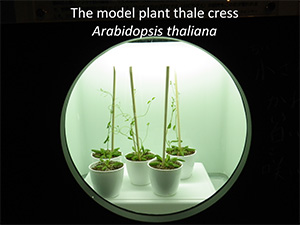Nagoya City Science Museum
TOP > Exhibition Guide > Keyword Search > Starting with "M" > Model organism > Biological Gallery
Biological Gallery

Purpose of Exhibition
The first step in biological experiments and education is to observe living organisms. For this purpose, living things that are easy to raise and to breed in the laboratory are selected and utilized in many laboratories. However, although various organisms appear in life science news and in textbooks, there is rarely the chance to actually see those organisms. Therefore, in this "Biological Gallery", more than 20 species of experimental organisms, educational organisms, organisms with bioluminescence and, etc. are raised and shown. Organisms such as these are active in the science and technology that supports our lives, the latest research, and the study of biology. They are small organisms, but observe their size, shape, behavior, etc. These are also the organisms that researchers are using so you may discover a new mystery. (There are no mammals, birds, or reptiles in this gallery. These are living beings, so the exhibition conditions change daily.)


Additional Knowledge
This Biological Gallery has the following four corners.
[Bottle garden]
Small organisms are exhibited in a transparent container. A magnifying glass is there, so you can observe these organisms up closer.
["Ing" exhibit]
The movement, growth etc. of living organisms was shot in frame (interval shooting) and the resulting video is shown sped up to compress the time scale. You can also shoot behind the large round window on the side. With the compressed time scale, you can see considerable movement, even by plants that are thought static.
[8 round windows]
This corner exhibits famous model organisms such as the amphibian Xenopus, the small zebrafish, and the model plant thale cress. As model organisms, organisms are selected that are easy to raise even in a laboratory and in which various life phenomena are easy to observe. Many researchers are using the same organisms in their research, so entire life cycles and nowadays gene functioning and genomes are much researched.
[Light emitting organisms]
Light emitting organisms have been found from bacteria to fish, except plants. The capacity for bioluminescence is not artificial but was mastered through evolution over the course of many years. For the mechanism for bioluminescence, there are organisms that produce light emitting substances within their bodies and organisms that have organs for raising bioluminescent bacteria. Here, we can really watch bioluminescence of fish, insects, mushrooms, bioluminescent bacteria and other organisms. An exhibit of such diverse light emitting organisms is rare anywhere in Japan. In order for you to be able to observe light shining from actual organisms, we take such steps as swapping organisms every day (for bioluminescent bacteria and mushroom) and reversing day and night to convince organisms that it is night when it is really day (for fireflies). It is lucky when you can observe the moment in which an organism lights up. Try peeking again and again.
Article by Chieko Ozaka,curator
